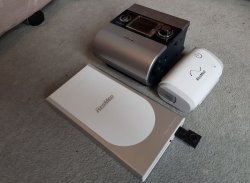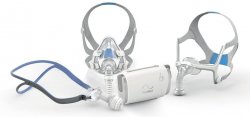coriander
Established Member
- Joined
- Sep 13, 2014
- Posts
- 1,812
- Qantas
- Gold
- Virgin
- Red
As we prepare for another overseas trip in a couple of days, I thought I would start a new thread about discussions about CPAP machines in general. I note there have been some posts in the past scattered across other threads and it was suggested a couple of months ago that perhaps we should have a dedicated CPAP thread. So here we go:
I thought I’d start with a user perspective of ResMed’s Airmini CPAP machine, billed as the ultimate travel CPAP machine (not a complete review – there are plenty of those on the web). I’ve owned one since May and it has been used on two overseas trips and one domestic.
The Airmini machine is certainly small - 13.6cm x 8.4cm x 5.2cm. However, a visual demonstration of its tiny size probably more instructive. From top to bottom the image below shows:
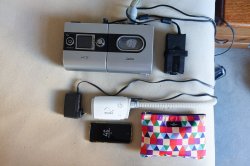
Rather than using the supplied bag, I pack the Airmini into three Cathay Pacific amenity packs. One pack contains the mask, another the tubing (and international adapter) and the third the Airmini and its power supply.
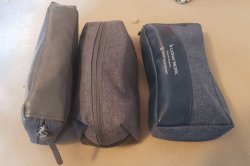
The Airmini comes with its own 2m tubing (thinner than standard CPAP machine tubing) and a choice of masks. Tubing also has a built-in waterless humidifcation system; this is located about 30 cm from the mask itself. Other masks and tubing are not compatible with the Airmini as the connections are completely different.
Generally when you purchase an Airmini, the seller will set it up for you using the parameters in your existing machine or the prescription provided by your sleep therapist. The Airmini also comes with the android or iPhone app which connects to your Airmini via Bluetooth and enables you to change settings within the machine as well as monitoring your sleep quality and quantity.
The Airmini machine itself is very quiet…… until you attach the tubing and mask. The humidifier section, with or without an inserted capsule, creates a large amount of noise (it’s about 30% louder with the HumidX capsule in place than out). On an aircraft the level of “white noise” pretty much masks the sound of the machine, but in a quiet hotel room the sound of air rushing is significantly louder. My ResMed S9 and Eson mask are almost completely silent. However on our last trip overseas were generally so tired by the time we went to bed that both my wife and I fell asleep very quickly, so the noise aspect may be less of a problem than you initially think. (I’ve not bothered with using the HumidX capsules and don’t wake up with a dry mouth – I usually don’t take the humidifier section of my S9 with me when I travel.) Certainly, it seemed to work well enough, the app telling me my sleep quality was always at or near 100% and I did feel fully refreshed every morning. One feature I really do like is the auto on / auto off: it turns on when you attach your mask and turns off within 5 seconds when you remove it - wonderful to not have to fumble around in the dark looking for the on/off button.
The power supply is a fixed 2-pin plug pack and runs at any voltage from 100-240V without the need to adjust settings on the plugpack. You will need an adapter if travelling overseas.
Qantas aircraft have AU power points and the A380 has dedicated medical power points in front of seats 11J, 11K – either one or two depending on number of people travelling. These are installed by QF ground crew when preparing the aircraft.
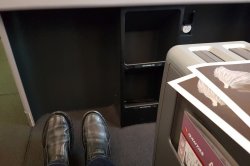
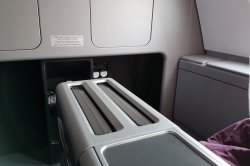
These run off a separate circuit to the entertainment system and are thus immune from power failure when the entertainment system has failed and has to be rebooted. These power points provide a very firm connection for your power supply (this is important – read on).
You do need to tell Qantas (in fact every airline) that you wish to use a CPAP machine – there is an appropriate form on their website – and Qantas’ staff at Special Handling are excellent and very helpful with any issues. On my request, they’ve inserted a comment into my profile that I use a CPAP machine so that I don’t have to notify them before each flight. For example, if you’re flying the A380 in J and you’re don’t have P1 or CL status, you’ll be unable to select row 11. A simple phone call to Special Handling and they will immediately allocate row 11 for you. By sheer coincidence, as I’m writing this post I received a phone call from QF Special Handling checking that I want to use my CPAP machine on our forthcoming 787 flight and offering me a medical power outlet seat – 8A or 8K. I declined, citing its proximity to the galley, preferring to stay in 3K.
As I said above the power supply is a plugpack, unlike the brick of my Resmed S9. While being compact its size and weight nevertheless can create a couple of issues. I would therefore recommend that you purchase a short (0.5 m) extension cord and take it with you on your travels.
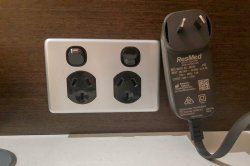
I thought I’d start with a user perspective of ResMed’s Airmini CPAP machine, billed as the ultimate travel CPAP machine (not a complete review – there are plenty of those on the web). I’ve owned one since May and it has been used on two overseas trips and one domestic.
The Airmini machine is certainly small - 13.6cm x 8.4cm x 5.2cm. However, a visual demonstration of its tiny size probably more instructive. From top to bottom the image below shows:
- my existing ResMed S9 Elite CPAP machine with its power supply;
- below it is the Airmini with its power supply;
- below the Airmini as a point of comparison, my Samsung S8 smart phone and a typical Qantas amenity pack.

Rather than using the supplied bag, I pack the Airmini into three Cathay Pacific amenity packs. One pack contains the mask, another the tubing (and international adapter) and the third the Airmini and its power supply.

The Airmini comes with its own 2m tubing (thinner than standard CPAP machine tubing) and a choice of masks. Tubing also has a built-in waterless humidifcation system; this is located about 30 cm from the mask itself. Other masks and tubing are not compatible with the Airmini as the connections are completely different.
Generally when you purchase an Airmini, the seller will set it up for you using the parameters in your existing machine or the prescription provided by your sleep therapist. The Airmini also comes with the android or iPhone app which connects to your Airmini via Bluetooth and enables you to change settings within the machine as well as monitoring your sleep quality and quantity.
The Airmini machine itself is very quiet…… until you attach the tubing and mask. The humidifier section, with or without an inserted capsule, creates a large amount of noise (it’s about 30% louder with the HumidX capsule in place than out). On an aircraft the level of “white noise” pretty much masks the sound of the machine, but in a quiet hotel room the sound of air rushing is significantly louder. My ResMed S9 and Eson mask are almost completely silent. However on our last trip overseas were generally so tired by the time we went to bed that both my wife and I fell asleep very quickly, so the noise aspect may be less of a problem than you initially think. (I’ve not bothered with using the HumidX capsules and don’t wake up with a dry mouth – I usually don’t take the humidifier section of my S9 with me when I travel.) Certainly, it seemed to work well enough, the app telling me my sleep quality was always at or near 100% and I did feel fully refreshed every morning. One feature I really do like is the auto on / auto off: it turns on when you attach your mask and turns off within 5 seconds when you remove it - wonderful to not have to fumble around in the dark looking for the on/off button.
The power supply is a fixed 2-pin plug pack and runs at any voltage from 100-240V without the need to adjust settings on the plugpack. You will need an adapter if travelling overseas.
Qantas aircraft have AU power points and the A380 has dedicated medical power points in front of seats 11J, 11K – either one or two depending on number of people travelling. These are installed by QF ground crew when preparing the aircraft.


These run off a separate circuit to the entertainment system and are thus immune from power failure when the entertainment system has failed and has to be rebooted. These power points provide a very firm connection for your power supply (this is important – read on).
You do need to tell Qantas (in fact every airline) that you wish to use a CPAP machine – there is an appropriate form on their website – and Qantas’ staff at Special Handling are excellent and very helpful with any issues. On my request, they’ve inserted a comment into my profile that I use a CPAP machine so that I don’t have to notify them before each flight. For example, if you’re flying the A380 in J and you’re don’t have P1 or CL status, you’ll be unable to select row 11. A simple phone call to Special Handling and they will immediately allocate row 11 for you. By sheer coincidence, as I’m writing this post I received a phone call from QF Special Handling checking that I want to use my CPAP machine on our forthcoming 787 flight and offering me a medical power outlet seat – 8A or 8K. I declined, citing its proximity to the galley, preferring to stay in 3K.
As I said above the power supply is a plugpack, unlike the brick of my Resmed S9. While being compact its size and weight nevertheless can create a couple of issues. I would therefore recommend that you purchase a short (0.5 m) extension cord and take it with you on your travels.
- Reason #1: many power points in hotels and on aircraft have become loose over time with many insertions and removals. The weight of the plugpack can be enough to have it fall out of its power point (exacerbated when it's plugged into an international adapter). This even happened on the new 787 LHR-PER when we hit a bit of turbulence.
- Reason #2: poor power point placement can preclude the use of the plugpack. Shown below is what I mean: this power point at a hotel in Brisbane is placed so close to the shelf that the plugpack can’t be inserted.

Last edited:








